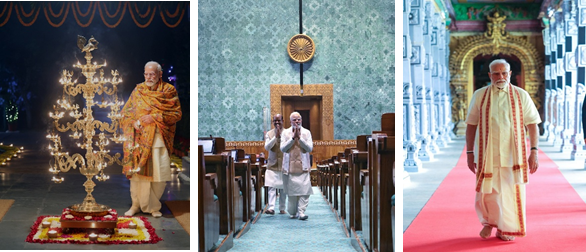Over the past eleven years, the Government of India has embarked on a wide-ranging cultural renaissance, blending tradition with progress and positioning India’s heritage at the heart of its national identity. From restoring ancient temples to honouring forgotten heroes, the country’s cultural revival is now seen as a pillar of both pride and progress.
Under the leadership of Prime Minister Narendra Modi, the government has prioritised the preservation, redevelopment and celebration of India’s civilisational legacy. Key religious and cultural landmarks across the country have witnessed transformative redevelopment, with improved infrastructure and public facilities designed to enhance the experience of pilgrims and tourists alike.
Transforming Sacred Spaces
The redevelopment of the Kashi Vishwanath Corridor in Varanasi is among the most notable projects. The corridor has opened up previously congested lanes around the temple and connected it directly to the ghats of the Ganga, allowing lakhs of devotees to visit in a more streamlined and spiritually immersive environment.
In Ujjain, the Mahakaal Lok Project has brought world-class amenities to the Mahakaleshwar Temple complex. The newly developed corridor and facilities reflect both ancient architecture and modern planning, turning the site into a cultural hub for spiritual tourism.
The Ram Mandir in Ayodhya, inaugurated in January 2024, has emerged as a major symbol of faith and heritage. The grand temple is not only a place of worship but also a tribute to the civilisational ethos that has shaped India’s spiritual history.
Other key sites include Kedarnath in Uttarakhand, where integrated development work has restored access and beauty to the revered Himalayan shrine. The installation of the statue of Adi Shankaracharya, rebuilt after destruction in the 2013 floods, is a powerful reminder of India’s enduring spiritual continuity.
Redevelopment efforts are also underway at the Juna Somnath Temple, including the construction of a scenic promenade and the Parvati Mandir, further enhancing the sanctity and accessibility of the Somnath complex.
In the northeast, Ma Kamakhya Temple in Assam has received infrastructure upgrades and pilgrim-friendly facilities, marking the government’s commitment to cultural sites across regions.
Protecting Intangible Heritage
Beyond physical sites, the government has also turned its attention to India’s intangible cultural heritage. Traditional art forms such as classical music, dance, and folk traditions are being preserved using modern digital tools. Efforts are underway to ensure that these time-honoured practices are passed on to future generations through institutional support and innovation.
Remembering the Forgotten
In a move to correct historical oversight, the government has placed renewed focus on honouring unsung heroes of India’s past. Through national memorials, educational campaigns and cultural programming, these forgotten figures are being reintegrated into India’s national consciousness.
A Civilisational Mission
The press release notes that these efforts reflect a broader civilisational mission: to preserve the spirit of India’s heritage while ensuring that culture and tradition evolve in harmony with advancements in technology, health, and infrastructure.
With projects that blend spiritual heritage, technological innovation, and inclusive access, India’s approach to cultural revival is both ambitious and holistic. As the nation looks to the future, it is doing so with one foot firmly planted in its rich and diverse past.










